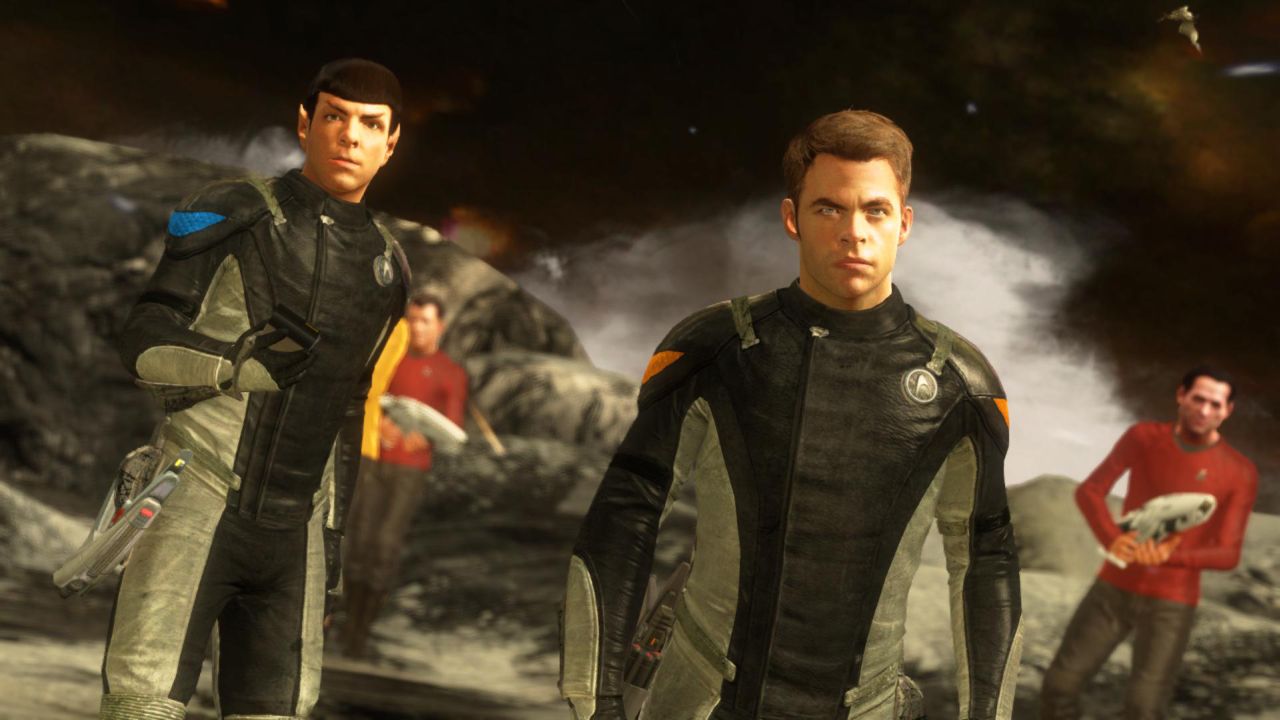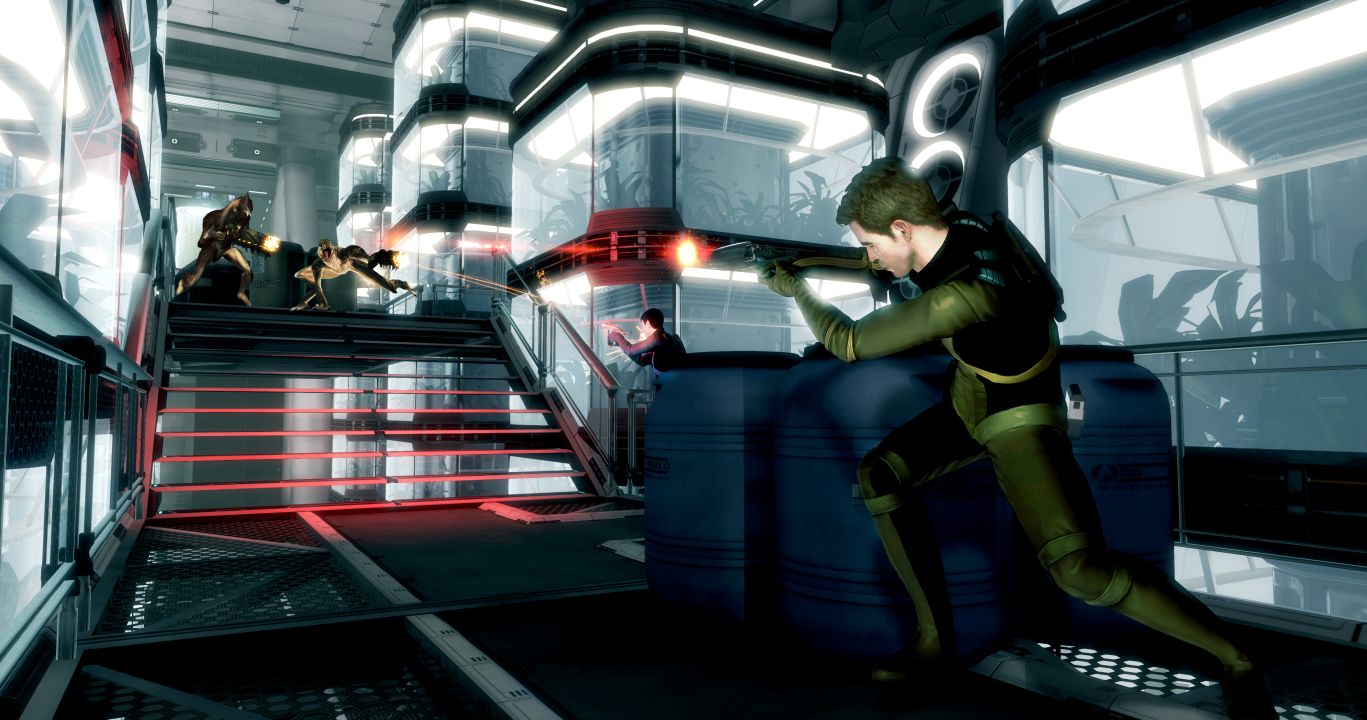Star Trek Review
When I was a child, every blockbuster summer movie would spark a new line of kids’ meal toys at a partner fast food chain. In my naive youth I was unaware, but looking back it was pretty clear that these toys were mostly for cheap promotion. A sure-fire way to put an advertisement of a kid’s beloved franchise in their hands to remind them of the most recent movie they could pester their parents about. Within minutes this toy inevitably ends up covered in fast food grease and discarded on the table while the child goes to play in the ball pit. This is how the new Star Trek games feels, like it should be included with a happy meal to remind people of the impending release of Paramount’s upcoming Star Trek: Into Darkness.
On its surface, Star Trek is a nice slice of cannon added to the newly forged world in the 2009 reboot of the franchise. The game tells the story of the New Vulcan project, an effort that goes awry when a species called the Gorn attack New Vulcan and quickly leap frog their way to the surrounding space stations, wreaking havoc wherever they go. Thus, it falls to the crew of the Enterprise, namely Captain Kirk and Commander Spock, to chase down the Gorn and eliminate the threat.

The narrative moves rather fluidly, and is easily the game’s strongest point. The Gorn have been a staple of the Star Trek universe and as neither Abrams nor the film’s producers appear to have a use for them in the upcoming movie, the game is a great place to work them in. Sometimes the narrative can become a bit contrived, where enemies kill everyone except for the damsel in distress for some loosely explained reason. However, if you turn off your brain and just enjoy the ride, it’s not half bad. In fact, the dialogue between the characters is rather well written, definitely in the same vein as the sarcastic, deadpan one-liners the recent film did so well. It also helps that the cast of the movies lend their respective voices to the game, providing the game a bit of credibility.
Unfortunately, that is one of the few good things to say about Star Trek. Barring the somewhat interesting story, the game is one giant, stinking mess. Once you start walking Kirk and Spock around the Enterprise, you will see that they have been poorly animated with thick torsos indicating maybe they’ve been stuffing down packages of Oreos since defeating the Romulans. These animations get worse as Spock and Kirk basically ghost through their environments, with awkward, rigid movements. The game gives a half-hearted attempt at Uncharted platforming, but these sections show how awful the animations are as characters’ hands disappear, reappear, and cling a couple centimeters above what they’re actually holding on to.

The stiff, unimpressive animations carry over to the cutscenes, which are not only horribly animated, but dreadfully directed. Each scene begins with a long loading screen, successfully taking you out of the action and detaching you from the story. Then the scene jolts to life, cut together like a highschooler’s fan film, with characters nonsensically moving about the environment. These cutscenes are so poorly constructed they would not have been acceptable in the previous console generation.
Once Star Trek starts throwing you into combat, things don’t get much better. At its absolute best, the gameplay is generic. The third-person cover shooting mechanics feel about as good as the original Mass Effect; clunky, unwieldy, but not unbearable. There are a couple tricks here and there in the combat, redirecting drones and turrets, but nothing that hasn’t been done better in other games. A limited selection of weapons and lack of creativity in the design make the battles uninteresting very quickly. To their credit, Digital Extremes attempts to change the gameplay up, not only with platforming, but swimming, teleporting, and flying sections. However, most of these curveballs miss their mark, with poorly explained scenarios and unrefined controls. Much of the gameplay is horrendously communicated – there are still several functions that I don’t understand – and used so poorly that you can almost see the design team going, “Oh crap, we forgot to use that more than once, let’s shove it in here.”
In theory, Kirk and Spock provide players with two different ways to experience the game. Kirk is the gun slinging, shoot-first ask questions later type, while Spock is more stealth based. The choice is rendered worthless as the game plays out the same either way. I tried approaching a playthrough as Spock with caution and strategy, but the level design more-or-less ensures things will devolve to a good ol’ fashioned shootout. Even when I did see a stealth opening, my AI partner would run around like a chicken with its head cut off, drawing attention to himself and blowing our cover. The partner AI is absolutely abysmal, they rarely help in combat, often get in the way, and take forever to assist you when you are down. The AI for enemies is equally bad. The Gorn must have conquered some dumb alien races, because their strategy often involves running directly up to you, then standing motionless while you shoot them in the head.

One of the few positive things to say about Star Trek’s gameplay is its drop-in online co-op mode. While playing as Spock, I left myself open to the online network and someone joined my game. Playing with someone helps solve the issues with partner AI, making battles go a little bit faster and moving the game along. At one point, I had to help Kirk up to a ledge and cover him while he extended a bridge. This was a rare instance of fun in Star Trek, but there aren’t enough of them.
Star Trek’s graphics are really rough, exemplified by the flat textures and glitchy environments. However, the art direction is so lackluster, the poor graphics don’t feel like much of a crime. The space stations are all white with black accent, sprinkled with the occasional foliage or other relatable touch. The alien planets are all rusty brown barren rocks. It’s clear that the team was trying to only pull visual inspiration from Abram’s Star Trek as any other artistic influence from the nearly 50 year old series seems ignored. But staying so slavishly close to Abram’s world has limited Digital Extremes in what they can imagine. Thus, by the sixth hour you will be begging for something new to look at.

The laziness of Star Trek extends beyond the gameplay, graphics, and art to almost every other aspect of the game. The sound design is underwhelming. It is important to note the brilliant Michael Giacchino, who scored Abram’s film, delivers a nice set of music that plays off its established themes while still being original. However, the other aspects of the sound design fall flat, just a general din that rarely provides any sort of aural cues or assistance in discerning the muddled world of the game. The worst of the sound design are the reactionary lines given by Spock and Kirk, which are repeated so often they become painfully annoying.
I wish I could say that Star Trek: The Video Game caters to fans of franchise, however the game is so directly pointed at the reboot and its sequel, I don’t think it resonates with the deeper lore. Either way, there are so few good ideas in Star Trek, it’s nearly impossible to recommend. While the story is passable and the dialogue enjoyable, you might as well watch Abram’s first film. You will get the same narrative quality, while not having to wade through mediocre gameplay, terrible graphics, and the myriad of other issues that bog down the fun. Just like those fast food toys, Star Trek: The Video Game feels more like a promotional tool rather than a quality product, taking advantage of franchise familiarity and the hype machine, then delivering something underwhelming and forgettable.
